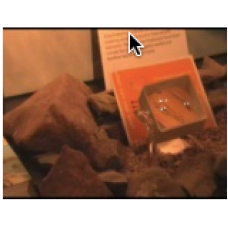Major Discovery in Stonehaven
Stonehaven featured as a main news item on the National News during the last week of January
2004, because of wee beastie found in Cowie.
An amateur fossil hunter from Kemnay,in Aberdeenshire, bus driver Michael Newman, had an amazing discovery.
He found a fossil of a millipede, which is estimated by experts to be around 420 million years old, and it is reckoned that if it had not been for the earth movement on the Highland Fault Line, he would not have found what is the oldest exposure on the globe for a terrestial ecosystem.
The Highland fault-line passes from along the Skatie Shore in Stonehaven in the east, to Helensburgh in the west, dividing Scotland into the Highlands and the Lowlands.
Mr Newman said that when he found the fossil it was fairly well preserved especially its legs.
He sent it to Dr Lyall Anderson at the National Museum of Scotland.
Together with experts at Yale University in USA, scientists in Edinburgh spent months examining the creature and dating it using moss spores trapped in the rock with it.
Before it could be revealed to the world, 3 years of research and review were undertaken.
A scientific paper published in January 2004 describes how this tiny creature was found to have spiracles (air breathing holes), evidence that life had crawled out of the primordial swamp to live and breathe air on dry land and this is thought to be the oldest evidence ever discovered of life on earth.
Mr Newman now has the honour of having his name included in the title of this ancient creepy crawly, now known as Pneumodesmusnewmani.
Why call it that? you ask.
Well according to Dr Lyall Anderson, curator of invertebrate paleontology at National Museum of
Scotland, 'pneumo' was from the greek word for air and 'desmus' meant millipede.
Stonehaven is also the birthplace of RW Thomson, the inventor of the pneumatic tyre and that was
why it was included and of course 'newmani' was in honour of Mr Newman.
Cowie harbour,has plenty of potential left. Newman is convinced there could be early eurypterids, or scorpion-related creatures, which may be found to possess breathing systems.
The site near Stonehaven is well known in fossil collecting circles for its abundance of arthropods, spidery animals such as sea scorpions, but all are aquatic animals as opposed to air breathing specimens like the Pneumodesmusnewmani.
A display of this can be seen in the Tolbooth Museum

